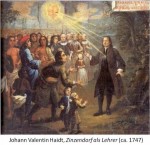Introduction Have you considered the influence of your family history (or how you frame your family history) on your vocation and daily life? In Personal Foundations in Ministry, one of my assignments will be to complete a genogram. Have you completed a genogram? If so, what does it reveal? If not, what do you think it might reveal? When preparing a class presentation on the The Incarnational Stream/Tradition, I could not resist delving into my family's Moravian roots1 and drawing connections with my present … [Read more...] about The Incarnational Stream & Higher Education: Family
